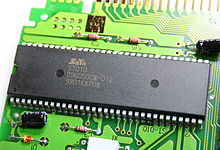NEC μPD7720
The NEC µPD7720 is the name of fixed point digital signal processors from NEC (currently Renesas Electronics). Announced in 1980, it became, along with the Texas Instruments TMS32010, one of the most popular DSPs of its day.
Background
In the late 1970s, telephone engineers were attempting to create technology with sufficient performance to enable digital touch-tone dialing.[1] Existing digital signal processing solutions required over a hundred chips and consumed significant amounts of power.[2] Intel responded to this potential market by introducing the Intel 2920, and integrated processor that, while it had both digital-to-analog and analog-to-digital converters, lacked additional features (such as a hardware multiplier) that would be found in later processors.[1] Announcements for the first "real" DSPs, the NEC µPD7720 and the Bell Labs DSP-1 chip, occurred the following year at the 1980 IEEE International Solid-State Circuits conference.[3] The µPD7720 first became available in 1981[4] and commercially available in late 1982 at a cost of 600 USD each (approx. $1,900 today).[2] Beyond their initial use in telephony, these processors found applications in disk drive and graphics controllers, speech synthesis and modems.[5]
Architecture
Detailed descriptions of the µPD7720 architecture are found in Chance (1990),[6] Sweitzer (1984)[7] and Simpson (1984).[8] Briefly, the NEC µPD7720 runs at 4 MHz frequency with 128-word data RAM, 512-word data ROM, and 512-word program memory, which has VLIW-like instruction format, enabling all of ALU operation, address register increment/decrement operation, and move operation in one cycle.
Variants

The NEC µPD77C25, which succeeded the µPD7720, runs at 8 MHz frequency with 256-word data RAM, 1,024-word data ROM, and 2,048-word program memory.
References
- ^ a b Hays, W. Patrick (March 2004). "DSPs: Back to the Future". Queue. 2 (1): 44. doi:10.1145/984458.984485. (subscription required)
- ^ a b Tretter, Steven A. (2008). Communication System Design Using DSP Algorithms. Springer. p. 2. ISBN 978-0-387--74885-6.
- ^ Waldner, Jean-Baptsite (2007). Nanocomputers and Swarm Intelligence. Wiley. p. 93. ISBN 978-1-84821-009-7.
- ^ :Anderson, Alexander John (1994). Foundations of Computer Technology. Chapman & Hall. p. 365. ISBN 0-412-59810-8.
- ^ Lee, Edward Ashford; Seshia, Sanjit Arunkumar (2011). Introduction to Embedded Systems: A Cyber-physical Systems Approach. p. 182. ISBN 978-0-557-70857-4.
- ^ Chance, R. J. (1990). "Devices Overview". In Jones, N. B.; Watson, J. D. McK. (eds.). Digital Signal Processing: Principles, Devices and Applications. Peter Peregrinus Ltd. pp. 10–12. ISBN 0863412106.
- ^ Sweitzer, S. (March 1984). "A low cost FFT chip set". IEEE International Conference on Acoustics, Speech and Signal Processing (ICASSP). 9: 371–373. doi:10.1109/ICASSP.1984.1172726.(subscription required)
- ^ Simpson, Robert J.; Terrell, Trevor J. (September 1984). "Digital filtering using the NEC µPD7720 signal processor". Microprocessing and Microprogramming. 14 (2): 67–78. doi:10.1016/0165-6074(84)90101-7.(subscription required)
External links
Datasheets for the UPD7720A, UPD7720AC and UPD7720AD are available here.
